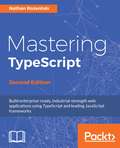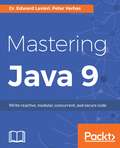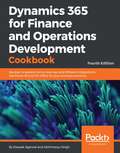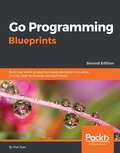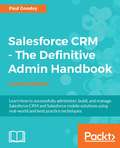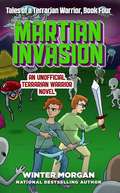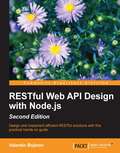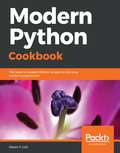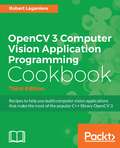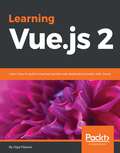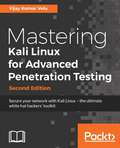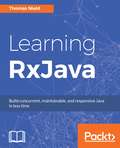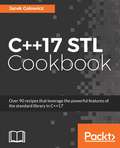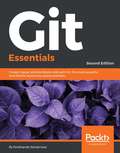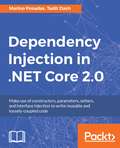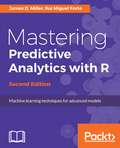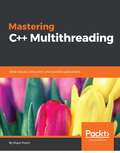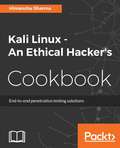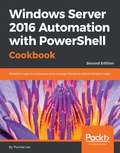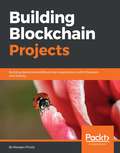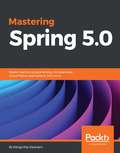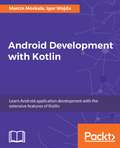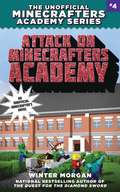- Table View
- List View
Mastering TypeScript - Second Edition
by Nathan RozentalsWhether you are a JavaScript developer who wants to learn TypeScript or an experienced TypeScript developer who wants to take your skills to the next level, this book is for you. If you are an enterprise JavaScript developer who builds web sites using Backbone, Marionette, Angular, Angular 2, Aurelia, or React.js, then this book will make you a better, more productive programmer.
Mastering Java 9: Master Advanced Java Features And Implement Them To Build Amazing Projects
by Dr Edward Lavieri Peter VerhasYour road to becoming a Java Ninja begins here! About This Book • This book will teach you to build highly scalable, fast, and secure applications • It covers major concepts introduced with the new version of Java 9, which includes modular programming, HTTP 2.0, API changes, and more • It will guide you with tools, techniques and best practices to enhance application development Who This Book Is For This book is for enterprise developers and existing Java developers. Basic knowledge of Java would help. What You Will Learn • Write modular Java applications in terms of the newly introduced module system • Migrate existing Java applications to modular ones • Understand how to use the G1 garbage collector in order to leverage the performance of your applications • Leverage the possibilities provided the newly introduced Java shell • Test your application's effectiveness with the JVM harness • See how Java 9 provides support for the http 2.0 standard • Use the new process API • Discover additional enhancements and features provided by Java 9 In Detail Java 9 and its new features add to the richness of the language, one of the languages most used by developers to build robust software applications. Java 9 comes with a special emphasis on modularity with its integration with Jigsaw. This would be your one-stop guide to mastering the language. You'll be provided with an overview and explanation of the new features introduced in Java 9 and the importance of the new APIs and enhancements. Some of the new features of Java 9 are ground-breaking and if you are an experienced programmer, you will be able to make your enterprise application leaner by learning these new features. You'll be provided with practical guidance in applying the newly acquired knowledge in regards to Java 9 and further information on future developments of the Java platform. This book will improve your productivity, making your application faster. By learning the best practices in Java, you'll become the “go-to” person in your organization. By the end of the book, you'll not only know the important concepts of Java 9, but you'll also have a nuanced understanding of the important aspects of programming with this great language. Style and approach Concepts and new terminology are explained in simple step-by-step manner. We cover a lot of real-world examples and case studies that will improve your Java productivity. This book covers new features on Java 9 and the much talked about Jigsaw integration.
Dynamics 365 for Finance and Operations Development Cookbook - Fourth Edition
by Deepak Agarwal Abhimanyu SinghOver 80 effective recipes to help you solve real-world Microsoft Dynamics 365 for Finance and Operations development problems About This Book • Learn all about the enhanced functionalities of Dynamics 365 for Finance and Operations and master development best practices • Develop powerful projects using new tools and features • Work through easy-to-understand recipes with step-by-step instructions and useful screenshots Who This Book Is For If you are a Dynamics AX developer primarily focused on delivering time-proven applications, then this book is for you. This book is also ideal for people who want to raise their programming skills above the beginner level, and at the same time learn the functional aspects of Dynamics 365 for Finance and Operations. Some X++ coding experience is expected. What You Will Learn • Explore data manipulation concepts in Dynamics 365 for Operations • Build scripts to assist data migration processes • Organize data in Dynamics 365 for Operations forms • Make custom lookups using AOT forms and dynamically generate them from X++ code • Create a custom electronic payment format and process a vendor payment using it • Integrate your application with Microsoft Office Suite and other external systems using various approaches • Export and import business data for further distribution or analysis • Improve your development efficiency and performance In Detail Microsoft Dynamics 365 for Finance and Operations has a lot to offer developers. It allows them to customize and tailor their implementations to meet their organization's needs. This Development Cookbook will help you manage your company or customer ERP information and operations efficiently. We start off by exploring the concept of data manipulation in Dynamics 365 for Operations. This will also help you build scripts to assist data migration, and show you how to organize data in forms. You will learn how to create custom lookups using Application Object Tree forms and generate them dynamically. We will also show you how you can enhance your application by using advanced form controls, and integrate your system with other external systems. We will help you script and enhance your user interface using UI elements. This book will help you look at application development from a business process perspective, and develop enhanced ERP solutions by learning and implementing the best practices and techniques. Style and approach The book follows a practical recipe-based approach, focusing on real-world scenarios and giving you all the information you need to build a strong Dynamics 365 for Finance and Operations implementation.
Go Programming Blueprints - Second Edition
by Mat RyerBuild real-world, production-ready solutions in Go using cutting-edge technology and techniques About This Book * Get up to date with Go and write code capable of delivering massive world-class scale performance and availability * Learn to apply the nuances of the Go language, and get to know the open source community that surrounds it to implement a wide range of start-up quality projects * Write interesting and clever but simple code, and learn skills and techniques that are directly transferrable to your own projects Who This Book Is For If you are familiar with Go and are want to put your knowledge to work, then this is the book for you. Go programming knowledge is a must. What You Will Learn * Build quirky and fun projects from scratch while exploring patterns, practices, and techniques, as well as a range of different technologies * Create websites and data services capable of massive scale using Go's net/http package, exploring RESTful patterns as well as low-latency WebSocket APIs * Interact with a variety of remote web services to consume capabilities ranging from authentication and authorization to a fully functioning thesaurus * Develop high-quality command-line tools that utilize the powerful shell capabilities and perform well using Go's in-built concurrency mechanisms * Build microservices for larger organizations using the Go Kit library * Implement a modern document database as well as high-throughput messaging queue technology to put together an architecture that is truly ready to scale * Write concurrent programs and gracefully manage the execution of them and communication by smartly using channels * Get a feel for app deployment using Docker and Google App Engine In Detail Go is the language of the Internet age, and the latest version of Go comes with major architectural changes. Implementation of the language, runtime, and libraries has changed significantly. The compiler and runtime are now written entirely in Go. The garbage collector is now concurrent and provides dramatically lower pause times by running in parallel with other Go routines when possible. This book will show you how to leverage all the latest features and much more. This book shows you how to build powerful systems and drops you into real-world situations. You will learn to develop high-quality command-line tools that utilize the powerful shell capabilities and perform well using Go's in-built concurrency mechanisms. Scale, performance, and high availability lie at the heart of our projects, and the lessons learned throughout this book will arm you with everything you need to build world-class solutions. You will get a feel for app deployment using Docker and Google App Engine. Each project could form the basis of a start-up, which means they are directly applicable to modern software markets. Style and approach This book provides fun projects that involve building applications from scratch. These projects will teach you to build chat applications, a distributed system, and a recommendation system.
Salesforce CRM - The Definitive Admin Handbook - Fourth Edition
by Paul GoodeyLearn how to successfully administer, build, and manage Salesforce CRM and Salesforce mobile solutions using real-world and best practice techniques About This Book • See the latest best practice Salesforce administration principles, gain real-world advice, and understand critical design considerations to set up and customize Salesforce CRM • This is a pragmatic guide to the key functions of customizing and setting up the application for enterprise security, user and data management, process automation, analytics, and mobile features • Step-by-step navigation and descriptions of the features of Salesforce CRM platform and clear guidance on the customization and administration of the application • Identify what is covered to create your own improved study guide for the certified administrator examination Who This Book Is For This book is for administrators who want to develop and strengthen their Salesforce CRM skills in the areas of configuration and system management. Whether you are a new administrator or a more experienced professional, this book will enhance your knowledge and understanding of the features of Salesforce CRM. What You Will Learn • Manage and administer user records and password policies • Configure and control the various organization-wide user interface features in Salesforce CRM • Set up and maintain users, profiles, and permission sets and administer appropriate security and login access mechanisms • Apply organization security • Understand the capabilities of the Salesforce CRM sharing model • Create, delete, and customize fields, page layout, and list views for custom and standard objects • Find out how Apex and Visualforce coding can be used in Salesforce CRM • Implement the mechanisms for data management • Discover the tools to import, update, transfer, and mass delete data In Detail Salesforce CRM's Winter '17 release offers a host of new features for CRM designed to transform your sales and marketing requirements. With this comprehensive guide to implementing Salesforce CRM, administrators of all levels can easily acquire deep knowledge of the platform. The book begins by guiding you through setting up users and the security settings and then progresses to configuration, data management, and data analytics. We swiftly move on to the setting up of organization wide features that affect the look and feel of the application. Process automation and approval mechanisms are covered next, along with the functional areas of Sales Cloud, Service Cloud, Marketing Cloud, and Salesforce Chatter. This book details Salesforce CRM system administration in a practical way and is an invaluable reference for both new administrators and experienced professionals. At the end of the book, techniques to further enhance the system and improve the return on investment Salesforce mobile apps and mobile administration are covered, along with Salesforce Adoption Manager. Every chapter is complete with a section containing example questions of the type that you might encounter in the certification examination. Style and approach This book takes a straightforward, no-nonsense approach to working with the Salesforce CRM platform. Filled with examples and use cases, the book presents the facts along with seasoned advice and real-world examples to ensure you have all the resources you need to become a more informed Salesforce Administrator.
Martian Invasion: An Unofficial Terrarian Warrior Novel (Tales of a Terrarian Warrior #4)
by Winter MorganAfter earning the The Buckets of Bolts achievement, Miles returns home to take a break and hang out. But then Asher and Owen, warrior friends who joined him on the last adventure, come to Miles pleading for his help in defeating Plantera. Things are dicey with Asher and Owen, as they need his help, but often treat him like a third wheel. Miles agrees to fight Plantera, in order to keep his friends and village safe. And the gang does feel like a trio of warriors after their defeat. Then they encounter the Golem. Being bolstered by their previous win helps them defeat the Golem. And they return home victorious.But who would have thought their biggest battle yet – and at home -- would come not from Terrarian enemies, but those from outer space?!
RESTful Web API Design with Node.JS - Second Edition
by Valentin BojinovThe ideal target audience for this book is web developers who have some experience with RESTful services. Familiarity with basic JavaScript programming techniques is required. No prior experience with Node.JS or Express is required.
Modern Python Cookbook
by Steven F. LottThe latest in modern Python recipes for the busy modern programmer About This Book * Develop succinct, expressive programs in Python * Learn the best practices and common idioms through carefully explained and structured recipes * Discover new ways to apply Python for the new age of development Who This Book Is For The book is for web developers, programmers, enterprise programmers, engineers, big data scientist, and so on. If you are a beginner, Python Cookbook will get you started. If you are experienced, it will expand your knowledge base. A basic knowledge of programming would help. What You Will Learn * See the intricate details of the Python syntax and how to use it to your advantage * Improve your code readability through functions in Python * Manipulate data effectively using built-in data structures * Get acquainted with advanced programming techniques in Python * Equip yourself with functional and statistical programming features * Write proper tests to be sure a program works as advertised * Integrate application software using Python In Detail Python is the preferred choice of developers, engineers, data scientists, and hobbyists everywhere. It is a great scripting language that can power your applications and provide great speed, safety, and scalability. By exposing Python as a series of simple recipes, you can gain insight into specific language features in a particular context. Having a tangible context helps make the language or standard library feature easier to understand. This book comes with over 100 recipes on the latest version of Python. The recipes will benefit everyone ranging from beginner to an expert. The book is broken down into 13 chapters that build from simple language concepts to more complex applications of the language. The recipes will touch upon all the necessary Python concepts related to data structures, OOP, functional programming, as well as statistical programming. You will get acquainted with the nuances of Python syntax and how to effectively use the advantages that it offers. You will end the book equipped with the knowledge of testing, web services, and configuration and application integration tips and tricks. The recipes take a problem-solution approach to resolve issues commonly faced by Python programmers across the globe. You will be armed with the knowledge of creating applications with flexible logging, powerful configuration, and command-line options, automated unit tests, and good documentation. Style and approach This book takes a recipe-based approach, where each recipe addresses specific problems and issues. The recipes provide discussions and insights and an explanation of the problems.
OpenCV 3 Computer Vision Application Programming Cookbook - Third Edition
by Robert LaganiereRecipes to help you build computer vision applications that make the most of the popular C++ library OpenCV 3 About This Book • Written to the latest, gold-standard specification of OpenCV 3 • Master OpenCV, the open source library of the computer vision community • Master fundamental concepts in computer vision and image processing • Learn about the important classes and functions of OpenCV with complete working examples applied to real images Who This Book Is For OpenCV 3 Computer Vision Application Programming Cookbook Third Edition is appropriate for novice C++ programmers who want to learn how to use the OpenCV library to build computer vision applications. It is also suitable for professional software developers who wish to be introduced to the concepts of computer vision programming. It can also be used as a companion book for university-level computer vision courses. It constitutes an excellent reference for graduate students and researchers in image processing and computer vision. What You Will Learn • Install and create a program using the OpenCV library • Process an image by manipulating its pixels • Analyze an image using histograms • Segment images into homogenous regions and extract meaningful objects • Apply image filters to enhance image content • Exploit the image geometry in order to relay different views of a pictured scene • Calibrate the camera from different image observations • Detect people and objects in images using machine learning techniques • Reconstruct a 3D scene from images In Detail Making your applications see has never been easier with OpenCV. With it, you can teach your robot how to follow your cat, write a program to correctly identify the members of One Direction, or even help you find the right colors for your redecoration. OpenCV 3 Computer Vision Application Programming Cookbook Third Edition provides a complete introduction to the OpenCV library and explains how to build your first computer vision program. You will be presented with a variety of computer vision algorithms and exposed to important concepts in image and video analysis that will enable you to build your own computer vision applications. This book helps you to get started with the library, and shows you how to install and deploy the OpenCV library to write effective computer vision applications following good programming practices. You will learn how to read and write images and manipulate their pixels. Different techniques for image enhancement and shape analysis will be presented. You will learn how to detect specific image features such as lines, circles or corners. You will be introduced to the concepts of mathematical morphology and image filtering. The most recent methods for image matching and object recognition are described, and you'll discover how to process video from files or cameras, as well as how to detect and track moving objects. Techniques to achieve camera calibration and perform multiple-view analysis will also be explained. Finally, you'll also get acquainted with recent approaches in machine learning and object classification. Style and approach This book will arm you with the basics you need to start writing world-aware applications right from a pixel level all the way through to processing video sequences.
Learning Vue.js 2
by Olga FilipovaLearn how to build amazing and complex reactive web applications easily with Vue.js About This Book • Learn how to propagate DOM changes across the website without writing extensive jQuery callbacks code. • Learn how to achieve reactivity and easily compose views with Vue.js and understand what it does behind the scenes. • Explore the core features of Vue.js with small examples, learn how to build dynamic content into preexisting web applications, and build Vue.js applications from scratch. Who This Book Is For This book is perfect for novice web developer seeking to learn new technologies or frameworks and also for webdev gurus eager to enrich their experience. Whatever your level of expertise, this book is a great introduction to the wonderful world of reactive web apps. What You Will Learn • Build a fully functioning reactive web application in Vue.js from scratch. • The importance of the MVVM architecture and how Vue.js compares with other frameworks such as Angular.js and React.js. • How to bring reactivity to an existing static application using Vue.js. • How to use plugins to enrich your applications. • How to develop customized plugins to meet your needs. • How to use Vuex to manage global application's state. In Detail Vue.js is one of the latest new frameworks to have piqued the interest of web developers due to its reactivity, reusable components, and ease of use. This book shows developers how to leverage its features to build high-performing, reactive web interfaces with Vue.js. From the initial structuring to full deployment, this book provides step-by-step guidance to developing an interactive web interface from scratch with Vue.js. You will start by building a simple application in Vue.js which will let you observe its features in action. Delving into more complex concepts, you will learn about reactive data binding, reusable components, plugins, filters, and state management with Vuex. This book will also teach you how to bring reactivity to an existing static application using Vue.js. By the time you finish this book you will have built, tested, and deployed a complete reactive application in Vue.js from scratch. Style and approach This book is a thorough, step-by-step guide showing readers how to build complete web apps with Vue.js. While teaching its intricacies, this book shows how to implement the MVVM architecture in the real world and build high-performing web interfaces.
Mastering Kali Linux for Advanced Penetration Testing, Second Edition
by Vijay Kumar VeluMastering Kali Linux for Advanced Penetration Testing will provide you with a number or proven techniques to defeat the latest defences on the networks using Kali Linux. From selecting the most effective tools, to rapidly compromising network security, to highlighting the techniques used to avoid detection.
Learning RxJava
by Thomas NieldReactive Programming with Java and ReactiveX About This Book • Explore the essential tools and operators RxJava provides, and know which situations to use them in • Delve into Observables and Subscribers, the core components of RxJava used for building scalable and performant reactive applications • Delve into the practical implementation of tools to effectively take on complex tasks such as concurrency and backpressure Who This Book Is For The primary audience for this book is developers with at least a fundamental mastery of Java. Some readers will likely be interested in RxJava to make programs more resilient, concurrent, and scalable. Others may be checking out reactive programming just to see what it is all about, and to judge whether it can solve any problems they may have. What You Will Learn • Learn the features of RxJava 2 that bring about many significant changes, including new reactive types such as Flowable, Single, Maybe, and Completable • Understand how reactive programming works and the mindset to "think reactively" • Demystify the Observable and how it quickly expresses data and events as sequences • Learn the various Rx operators that transform, filter, and combine data and event sequences • Leverage multicasting to push data to multiple destinations, and cache and replay them • Discover how concurrency and parallelization work in RxJava, and how it makes these traditionally complex tasks trivial to implement • Apply RxJava and Retrolambda to the Android domain to create responsive Android apps with better user experiences • Use RxJava with the Kotlin language to express RxJava more idiomatically with extension functions, data classes, and other Kotlin features In Detail RxJava is a library for composing asynchronous and event-based programs using Observable sequences for the JVM, allowing developers to build robust applications in less time. Learning RxJava addresses all the fundamentals of reactive programming to help readers write reactive code, as well as teach them an effective approach to designing and implementing reactive libraries and applications. Starting with a brief introduction to reactive programming concepts, there is an overview of Observables and Observers, the core components of RxJava, and how to combine different streams of data and events together. You will also learn simpler ways to achieve concurrency and remain highly performant, with no need for synchronization. Later on, we will leverage backpressure and other strategies to cope with rapidly-producing sources to prevent bottlenecks in your application. After covering custom operators, testing, and debugging, the book dives into hands-on examples using RxJava on Android as well as Kotlin. Style and approach This book will be different from other Rx books, taking an approach that comprehensively covers Rx concepts and practical applications.
C++17 STL Cookbook
by Jacek GalowiczOver 90 recipes that leverage the powerful features of the Standard Library in C++17 About This Book • Learn the latest features of C++ and how to write better code by using the Standard Library (STL). Reduce the development time for your applications. • Understand the scope and power of STL features to deal with real-world problems. • Compose your own algorithms without forfeiting the simplicity and elegance of the STL way. Who This Book Is For This book is for intermediate-to-advanced C++ programmers who want to get the most out of the Standard Template Library of the newest version of C++: C++ 17. What You Will Learn • Learn about the new core language features and the problems they were intended to solve • Understand the inner workings and requirements of iterators by implementing them • Explore algorithms, functional programming style, and lambda expressions • Leverage the rich, portable, fast, and well-tested set of well-designed algorithms provided in the STL • Work with strings the STL way instead of handcrafting C-style code • Understand standard support classes for concurrency and synchronization, and how to put them to work • Use the filesystem library addition available with the C++17 STL In Detail C++ has come a long way and is in use in every area of the industry. Fast, efficient, and flexible, it is used to solve many problems. The upcoming version of C++ will see programmers change the way they code. If you want to grasp the practical usefulness of the C++17 STL in order to write smarter, fully portable code, then this book is for you. Beginning with new language features, this book will help you understand the language's mechanics and library features, and offers insight into how they work. Unlike other books, ours takes an implementation-specific, problem-solution approach that will help you quickly overcome hurdles. You will learn the core STL concepts, such as containers, algorithms, utility classes, lambda expressions, iterators, and more, while working on practical real-world recipes. These recipes will help you get the most from the STL and show you how to program in a better way. By the end of the book, you will be up to date with the latest C++17 features and save time and effort while solving tasks elegantly using the STL. Style and approach This recipe-based guide will show you how to make the best use of C++ together with the STL to squeeze more out of the standard language
Git Essentials - Second Edition: Create, merge, and distribute code with Git, the most powerful and flexible versioning system available
by Ferdinando SantacroceDive and explore into the latest addons of the latest Git. About This Book • Master all the basic concepts of Git to protect your code and make it easier to evolve • Use Git proficiently, and learn how to resolve day-by-day challenges easily • This step-by-step guide is packed with examples to help you learn and work with Git's internals Who This Book Is For If you are a software developer with little or no experience of versioning systems, or you are familiar with other centralized versioning systems, then this book is for you. If you have experience in server and system management and need to broaden your use of Git from a DevOps perspective, this book contains everything you need. What You Will Learn • Master Git fundamentals • Be able to "visualize," even with the help of a valid GUI tool • Write principal commands in a shell • Figure out the right strategy to run change your daily work with few or no annoyances • Explore the tools used to migrate to Git from the Subversion versioning system without losing your development history • Plan new projects and repositories with ease, using online services, or local network resources In Detail Since its inception, Git has attracted skilled developers due to its robust, powerful, and reliable features. Its incredibly fast branching ability transformed a piece of code from a niche tool for Linux Kernel developers into a mainstream distributed versioning system. Like most powerful tools, Git can be hard to approach since it has a lot of commands, subcommands, and options that easily confuse newcomers. The 2nd edition of this very successful book will help you overcome this fear and become adept in all the basic tasks in Git. Building upon the success of the first book, we start with a brief step-by-step installation guide; after this, you'll delve into the essentials of Git. For those of you who have bought the first edition, this time we go into internals in far greater depth, talking less about theory and using much more practical examples. The book serves as a primer for topics to follow, such as branching and merging, creating and managing a GitHub personal repository, and fork and pull requests. You'll then learn the art of cherry-picking, taking only the commits you want, followed by Git blame. Finally, we'll see how to interoperate with a Subversion server, covering the concepts and commands needed to convert an SVN repository into a Git repository. To conclude, this is a collection of resources, links, and appendices to satisfy even the most curious. Style and approach This short guide will help you understand the concepts and fundamentals of GIT is a step-by-step manner.
Dependency Injection in .NET Core 2.0
by Marino Posadas Tadit DashInject dependencies and write highly maintainable and flexible code using the new .NET Core DI Engine About This Book • Identify when to use the constructors, parameters, setters, or Interface Injection, for best results • Build dependencies not only for MVC within .NET but also for other frontend tools such as Angular • Create specific components or services to cover discrete and separate pieces of functionality and call them when needed. Who This Book Is For C# and .NET developers who have no idea what DI is and would like to understand how to implement it in their applications. What You Will Learn • Understand the concept of DI and its implications in modern software construction • Learn how DI is already implemented in today's frameworks. • Analyze how DI can be used with current software to improve maintainability and scalability. • Learn the use of DI in .NET Core • Get used to the possibilities that DI offers the ASP.NET Core developer in different scenarios. • Learn about good practices and refactoring legacy code. In Detail .NET Core provides more control than ever over web application architectures. A key point of this software architecture is that it's based on the use of Dependency Injection as a way to properly implement the Dependency Inversion principle proposed in the SOLID principles established by Robert C. Martin. With the advent of .NET Core, things have become much simpler with Dependency Injection built into the system. This book aims to give you a profound insight into writing loosely-coupled code using the latest features available in .NET Core. It talks about constructors, parameter, setters, and interface injection, explaining in detail, with the help of examples, which type of injection to use in which situation. It will show you how to implement a class that creates other classes with associated dependencies, also called IoC containers, and then create dependencies for each MVC component of ASP.NET Core. You'll learn to distinguish between IoC containers, the use of Inversion of Control, and DI itself, since DI is just a way of implementing IoC via these containers. You'll also learn how to build dependencies for other frontend tool such as Angular. You will get to use the in-built services offered by .NET Core to create your own custom dependencies. Towards the end, we'll talk about some patterns and anti-patterns for Dependency Injection along with some techniques to refactor legacy applications and inject dependencies. Style and Approach Filled with examples, this book will take you through various techniques for injecting dependencies into your applications with or without the use of frameworks.
Mastering Predictive Analytics with R - Second Edition
by James D. Miller Rui Miguel ForteMaster the craft of predictive modeling in R by developing strategy, intuition, and a solid foundation in essential concepts About This Book • Grasping the major methods of predictive modeling and moving beyond black box thinking to a deeper level of understanding • Leveraging the flexibility and modularity of R to experiment with a range of different techniques and data types • Packed with practical advice and tips explaining important concepts and best practices to help you understand quickly and easily Who This Book Is For Although budding data scientists, predictive modelers, or quantitative analysts with only basic exposure to R and statistics will find this book to be useful, the experienced data scientist professional wishing to attain master level status , will also find this book extremely valuable.. This book assumes familiarity with the fundamentals of R, such as the main data types, simple functions, and how to move data around. Although no prior experience with machine learning or predictive modeling is required, there are some advanced topics provided that will require more than novice exposure. What You Will Learn • Master the steps involved in the predictive modeling process • Grow your expertise in using R and its diverse range of packages • Learn how to classify predictive models and distinguish which models are suitable for a particular problem • Understand steps for tidying data and improving the performing metrics • Recognize the assumptions, strengths, and weaknesses of a predictive model • Understand how and why each predictive model works in R • Select appropriate metrics to assess the performance of different types of predictive model • Explore word embedding and recurrent neural networks in R • Train models in R that can work on very large datasets In Detail R offers a free and open source environment that is perfect for both learning and deploying predictive modeling solutions. With its constantly growing community and plethora of packages, R offers the functionality to deal with a truly vast array of problems. The book begins with a dedicated chapter on the language of models and the predictive modeling process. You will understand the learning curve and the process of tidying data. Each subsequent chapter tackles a particular type of model, such as neural networks, and focuses on the three important questions of how the model works, how to use R to train it, and how to measure and assess its performance using real-world datasets. How do you train models that can handle really large datasets? This book will also show you just that. Finally, you will tackle the really important topic of deep learning by implementing applications on word embedding and recurrent neural networks. By the end of this book, you will have explored and tested the most popular modeling techniques in use on real- world datasets and mastered a diverse range of techniques in predictive analytics using R. Style and approach This book takes a step-by-step approach in explaining the intermediate to advanced concepts in predictive analytics. Every concept is explained in depth, supplemented with practical examples applicable in a real-world setting.
Mastering C++ Multithreading
by Maya PoschMaster multithreading and concurrent processing with C++ About This Book • Delve into the fundamentals of multithreading and concurrency and find out how to implement them • Explore atomic operations to optimize code performance • Apply concurrency to both distributed computing and GPGPU processing Who This Book Is For This book is for intermediate C++ developers who wish to extend their knowledge of multithreading and concurrent processing. You should have basic experience with multithreading and be comfortable using C++ development toolchains on the command line. What You Will Learn • Deep dive into the details of the how various operating systems currently implement multithreading • Choose the best multithreading APIs when designing a new application • Explore the use of mutexes, spin-locks, and other synchronization concepts and see how to safely pass data between threads • Understand the level of API support provided by various C++ toolchains • Resolve common issues in multithreaded code and recognize common pitfalls using tools such as Memcheck, CacheGrind, DRD, Helgrind, and more • Discover the nature of atomic operations and understand how they can be useful in optimizing code • Implement a multithreaded application in a distributed computing environment • Design a C++-based GPGPU application that employs multithreading In Detail Multithreaded applications execute multiple threads in a single processor environment, allowing developers achieve concurrency. This book will teach you the finer points of multithreading and concurrency concepts and how to apply them efficiently in C++. Divided into three modules, we start with a brief introduction to the fundamentals of multithreading and concurrency concepts. We then take an in-depth look at how these concepts work at the hardware-level as well as how both operating systems and frameworks use these low-level functions. In the next module, you will learn about the native multithreading and concurrency support available in C++ since the 2011 revision, synchronization and communication between threads, debugging concurrent C++ applications, and the best programming practices in C++. In the final module, you will learn about atomic operations before moving on to apply concurrency to distributed and GPGPU-based processing. The comprehensive coverage of essential multithreading concepts means you will be able to efficiently apply multithreading concepts while coding in C++. Style and approach This book is filled with examples that will help you become a master at writing robust concurrent and parallel applications in C++.
Kali Linux - An Ethical Hacker's Cookbook
by Himanshu SharmaWith the current rate of hacking, it is very important to pentest your environment in order to ensure advanced-level security. This book will be packed with practical recipes that will quickly get you started with Kali Linux (version 2016.2) as per your requirements and move on to core functionalities.
Windows Server 2016 Automation with PowerShell Cookbook - Second Edition
by Thomas LeeOver 100 recipes to help you leverage PowerShell to automate Windows Server 2016 manual tasks About This Book • Automate Windows server tasks with the powerful features of the PowerShell Language • Master new features such as DevOps, containers, and Nano servers, and speed up their performance using PowerShell • Improve PowerShell's usability, and control and manage Windows-based environments by working through inviting recipes Who This Book Is For If you are a systems administrator, engineer, or an architect working with Windows Server 2016 and want to automate tasks with PowerShell, then this book is for you. A basic knowledge of PowerShell is expected. What You Will Learn • Streamline routine administration processes • Improve the performance and storage of your Windows server with enhanced large-scale PowerShell scripts • Use DSC to leverage Windows server features • Generate automatic reports that highlight unexpected changes in your environment • Monitor performance and report on system utilization using detailed graphs and analysis • Create and manage a reliable and redundant Hyper-V environment • Manage your enterprise's patch level • Utilize multiple tools and protocols to manage your environment In Detail This book showcases several ways that Windows administrators can use to automate and streamline their job. You'll start with the PowerShell and Windows Server fundamentals, where you'll become well versed with PowerShell and Windows Server features. In the next module, Core Windows Server 2016, you'll implement Nano Server, manage Windows updates, and implement troubleshooting and server inventories. You'll then move on to the Networking module, where you'll manage Windows network services and network shares. The last module covers Azure and DSC, where you will use Azure on PowerShell and DSC to easily maintain Windows servers. Style and approach This is a practical guide packed with attractive recipes to help you effectively use PowerShell to accelerate your daily administrative tasks with Windows server.
Building Blockchain Projects
by Narayan PrustyThis book is for JavaScript developers who now want to create tamper-proof data (and transaction) applications using Blockchain and Ethereum. Those who are interested in cryptocurrencies and the logic and database empowering it will find this book extremely useful.
Mastering Spring 5.0
by Ranga Rao KaranamDevelop cloud native applications with microservices using Spring Boot, Spring Cloud, and Spring Cloud Data Flow About This Book • Explore the new features and components in Spring • Evolve towards micro services and cloud native applications • Gain powerful insights into advanced concepts of Spring and Spring Boot to develop applications more effectively • Understand the basics of Kotlin and use it to develop a quick service with Spring Boot Who This Book Is For This book is for an experienced Java developer who knows the basics of Spring, and wants to learn how to use Spring Boot to build applications and deploy them to the cloud. What You Will Learn • Explore the new features in Spring Framework 5.0 • Build microservices with Spring Boot • Get to know the advanced features of Spring Boot in order to effectively develop and monitor applications • Use Spring Cloud to deploy and manage applications on the Cloud • Understand Spring Data and Spring Cloud Data Flow • Understand the basics of reactive programming • Get to know the best practices when developing applications with the Spring Framework • Create a new project using Kotlin and implement a couple of basic services with unit and integration testing In Detail Spring 5.0 is due to arrive with a myriad of new and exciting features that will change the way we've used the framework so far. This book will show you this evolution—from solving the problems of testable applications to building distributed applications on the cloud. The book begins with an insight into the new features in Spring 5.0 and shows you how to build an application using Spring MVC. You will realize how application architectures have evolved from monoliths to those built around microservices. You will then get a thorough understanding of how to build and extend microservices using Spring Boot. You will also understand how to build and deploy Cloud-Native microservices with Spring Cloud. The advanced features of Spring Boot will be illustrated through powerful examples. We will be introduced to a JVM language that's quickly gaining popularity - Kotlin. Also, we will discuss how to set up a Kotlin project in Eclipse. By the end of the book, you will be equipped with the knowledge and best practices required to develop microservices with the Spring Framework. Style and Approach This book follows an end-to-end tutorial approach with lots of examples and sample applications, covering the major building blocks of the Spring framework.
Mob School Survivor: The Creeper Diaries, An Unofficial Minecrafter's Novel (Creeper Diaries #1)
by Amanda Brack Greyson MannThe launch of an exciting, hilarious new series narrated by an underdog every Minecrafter can relate to. Gerald Creeper Jr. is a self-proclaimed pacifist (which, by the way, has nothing to do with a pacifier), but he finds himself in the war zone when he starts his first year at Mob Middle School. At his new school, every monster in the Overworld is jockeying for power, and the skeletons seem to have it out for him. Armed with a 30-day plan (he can thank his mom’s self-help obsession for that), Gerald makes it his mission to use his brains-instead of his blasts-to survive the school year. It all starts with: Day 1: Come up with a nickname. (Gerald is not gonna cut it.) Day 2: Keep a low profile. (Not easy when your new best friend is a super bouncy slime!) Day 3: Avoid being target practice for skeletons, and somehow get in with super-popular Eddy Enderman. (Easier said than done.) The first book in this laugh-out-loud funny, heavily illustrated, diary format series for Minecrafters follows the most misunderstood hostile mob in the Overworld. It’s not easy being green . . . or explosive!
Android Development with Kotlin
by Nish TahirThis book is for Android developers who are looking to cut down on heavy Java boilerplate code and write concise code while continuing to build high-quality and robust applications. It assumes no prior knowledge of Kotlin, but does not touch upon basic Android stuff.
Puppet 4.10 Beginner's Guide - Second Edition
by John ArundelPuppet is great for developers, system administrators, IT professionals, and anyone laying the foundation for DevOps practices – this comprehensive guide will get you up to speed, all the way from installation to automation to the latest features of Puppet 4.10. About This Book • Develop skills to run Puppet 4.10 on single or multiple servers without hiccups • Use Puppet to spin up and manage cloud resources such as Amazon EC2 instances • Take full advantage of the powerful new features of Puppet 4.10, including loops, data types, structured facts, R10K module management, control repos, and EPP templates Who This Book Is For Puppet Beginner's Guide, Second Edition is designed for those who are new to Puppet, including system administrators and developers who are looking to manage computer server systems for configuration management. No prior programming or system administration experience is assumed. What You Will Learn • Covers the latest Puppet 4.10 release • Install and set up Puppet and discover the latest and most advanced features • Configure, build, and run containers in production using Puppet's industry-leading Docker support • Deploy configuration files and templates at super-fast speeds and manage user accounts and access control • Automate your IT infrastructure • Use the latest features in Puppet 4 onward and its official modules • Manage clouds, containers, and orchestration • Get to know the best practices to make Puppet more reliable and increase its performance In Detail Puppet 4.10 Beginner's Guide, Second Edition, gets you up and running with the very latest features of Puppet 4.10, including Docker containers, Hiera data, and Amazon AWS cloud orchestration. Go from beginner to confident Puppet user with a series of clear, practical examples to help you manage every aspect of your server setup. Whether you're a developer, a system administrator, or you are simply curious about Puppet, you'll learn Puppet skills that you can put into practice right away. With practical steps giving you the key concepts you need, this book teaches you how to install packages and config files, create users, set up scheduled jobs, provision cloud instances, build containers, and so much more. Every example in this book deals with something real and practical that you're likely to need in your work, and you'll see the complete Puppet code that makes it happen, along with step-by-step instructions for what to type and what output you'll see. All the examples are available in a GitHub repo for you to download and adapt for your own server setup. Style and approach This tutorial is packed with quick step-by-step instructions that are immediately applicable for beginners. This is an easy-to-read guide, to learn Puppet from scratch, that explains simply and clearly all you need to know to use this essential IT power tool, while applying these solutions to real-world scenarios.
Attack on Minecrafters Academy: The Unofficial Minecrafters Academy, Book Four (The Unofficial Minecrafters Academy Series #4)
by Winter MorganIt’s a new school year at Minecrafters Academy, and Lucy is returning-this time not as a student, but as headmaster. She sets to work preparing the school for the Overworld Academic Olympics, a prestigious competition that will test their combat, treasure hunting, and potions brewing skills.But training is interrupted when an explosion rocks the campus. The school is under attack from a mysterious culprit-and everyone is a suspect.Meanwhile, Julia, a new student at Minecrafters Academy, is having a hard time adjusting to her new life on campus. When she catches her roommate, Hallie, sneaking around just after the attacks on the school, Julia begins to suspect her. Then Hallie goes missing right before another round of explosions and a massive creeper invasion. It’s up to the students and teachers of Minecrafters Academy to track down the villain behind the attacks and protect not just the school, but the entire Overworld.As the Unofficial Minecrafters Academy series continues, new friends and sinister new foes will be revealed.
